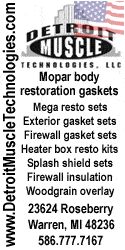Very interesting... Well I suppose if nothing else changed, and you got valve float, then that's what it wold most likely be, the springs losing tension. It's amazing how valve springs can actually be so good for so long IMO. Look at stock valves springs - really they are only only just wire, spring steel in a coil. But can last 40 years of use and still be able to keep the engine going well enough in normal circumstances.They do lose pressure, which was likely contributing to valve float. I can't imagine what else it could have been. That's when I replaced the springs with new ones, but at higher pressures. I just don't have a spring tester handy to help figure out their life cycle and rate of degradation. My engine builder is a couple of hours away and I don't visit too often. But they do last several seasons, even with the Stock class cam profiles, which tend to be as aggressive as you can get with composite flat tappet lifters. The only cam specs that are limited are lifters (flat if it came flat OEM) and cam lift. Duration and opening/closing ramps are much more aggressive than typical performance cams.
There are different materials and processes (cryo & micro finishing/polishing) which can prolong spring life. But it may not always be feasible. Some race combos replace springs very often, depending on the application, rpm and cam profile, even with better metallurgy & treatments.
At the beginning of this year I was considering sending my 8 3/4 pumpkin to Sydney (opposite end of the country for me) to get cryo-processed. I spoke to the fellow who owned the business. They cryo treat racing parts with liquid nitrogen for stronger and more durable life. I was surprised when he said that he puts all his valve springs in the treatment as well. It lasts a whole week - they slowly take the parts down to minus whatever it is (super cold) and keep them there for a few days, then slowly bring them back to room temperature, and by slowly, it is around 5 days! He races and he said the valve springs last a great deal longer. What it does is makes the metal much more uniform and perfect in grain structure, it takes out the micro stresses that could never been seen even under a microscope and aligns the grains in the structure. In the case of my pumpkin, he said he puts the whole thing in there, no need to disassemble it. It was very interesting.
















